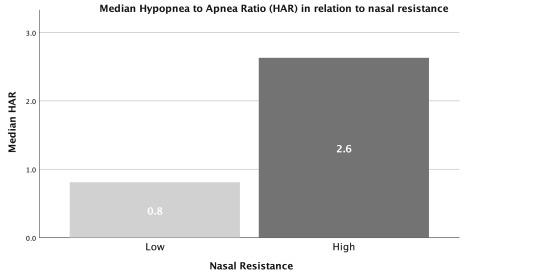Impact of nasal resistance on the distribution of apneas and hypopneas in obstructive sleep apnea |
| |
| Affiliation: | 1. Department of Oto-Rhino-Laryngology, Head and Neck Surgery and Sleep Medicine, Lovisenberg Diaconal Hospital, Norway;2. Medical Faculty, University of Lund, Sweden |
| |
| Abstract: | 
BackgroundThis study aims to investigate how increased nasal resistance affects respiratory variables in obstructive sleep apnea (OSA). In this setting, to assess how nasal resistance, as measured by 4-phase rhinomanometry, affects the distribution of hypopneas and apneas when measured with routine Sleep Polygraphy (PG).MethodsPG recordings were analysed and 4-phase rhinomanometry was conducted. Crude differences between groups were compared using Mann–Whitney Wilkoxon test. Odds for higher nasal resistance were modelled using logistic regression. All tests were two-sided. P < 0.05 was considered statistically significant.ResultsIn sum, 126 OSA patients referred to our center examined with PG were included. OSA Patients with a higher ratio of hypopneas relative to apneas are more than three times more likely (OR = 3.72, 95%CI [1.30–10.66], p = 0.015) to have increased nasal resistance as measured by 4-phase rhinomanometry, compared to those who have a lower ratio of hypopneas relative to apneas, regardless of OSA severity.The median Hypopnea to Apnea Ratio (HAR) in the low nasal resistance group was 0.8 compared to 2.6 in the high nasal resistance group (p = 0.000). The median apnea index in the low nasal resistance group was 13.6, in the high nasal group it was 5.2 (p = 0.001).ConclusionsOur investigation shows that OSA patients presenting with increased nasal resistance demonstrate significant differences in the distribution of hypopneas and apneas. OSA patients with increased nasal resistance exhibit a significantly lower apnea index and a higher hypopnea to apnea ratio compared to OSA patients presenting with low nasal resistance. Thus, analysis of the HAR in sleep studies is a useful tool to identify patients who may potentially have nasal obstruction as part of their respiratory pathophysiology. We therefore recommend that OSA patients with a predominance of hypopneas relative to apneas should undergo further nasal measurements. |
| |
| Keywords: | Obstructive sleep apnea Respiratory system diagnostic technique Sleep hypopnea Nasal obstruction Rhinomanometry |
| 本文献已被 ScienceDirect 等数据库收录! |
|

